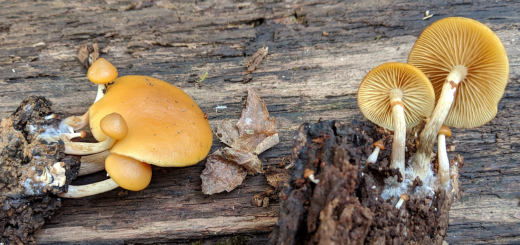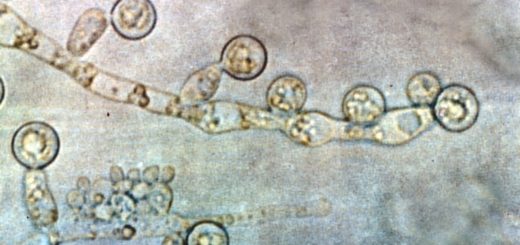#091: Amatoxins
This group of poisons contains the most deadly of all mushroom toxins and accounts for the majority of deaths by mushroom poisoning (perhaps up to 95% globally). Amatoxins are found in many Amanita species (from which the group derives its name) – most notably in the Destroying Angels (Amanita virosa and relatives, see FFF#050) and in the Death Cap (Amanita phalloides, see FFF#051) – as well as in some mushrooms in the genera Galerina, Lepiota, and Conocybe.
All amatoxins share a similar core structure: eight amino acids arranged into two rings. There are eight varieties of amatoxin, each with a different combination of modifications added to the core ring structure. The most common varieties of amatoxin are α-amanitin and β-amanitin. These compounds are all very stable and cannot be destroyed by cooking, freezing, or by chemical processes inside the body. Amatoxins are extremely small as proteins go, but their size and shape make them perfectly suited for binding to and deactivating RNA Polymerase II. They can also deactivate RNA Polymerase III, but not nearly as efficiently.
In order to live, any cell must take the information stored in its DNA and use it to build proteins. There are two steps to this process: transcription and translation. In transcription, the DNA sequence is copied onto an mRNA molecule. In translation, the mRNA sequence is used to assemble a protein. RNA Polymerase II is important in transcription, where it reads the DNA code and assembles the proper mRNA sequence. RNA Polymerase III is also used in transcription, where it produces other kinds of RNA molecules that do not code for proteins.
When RNA Polymerase II or III is bound by an amatoxin, it gets stuck and can no longer build mRNA molecules. In the case of RNA Polymerase II – the main target of amatoxins – this prevents new proteins from being made. As the old proteins begin to wear out, the cell starts to die. The amatoxins are very efficient at binding RNA Polymerase II, so only 0.1mg per kilogram of body weight is needed to kill a person. This amount can be found in about 50 grams (0.1 pounds or 1.8 ounces) of amatoxin-producing mushrooms. Amanitas tend to be medium-sized to large mushrooms, so most people who eat them consume much more than 50 grams.
In order for amatoxins to cause damage, they must enter the blood stream. Luckily, they cannot enter through the skin. Handling poisonous mushrooms is safe (although it’s probably a good idea to wash your hands afterward); the amatoxins start causing damage only after you eat the mushroom. Amatoxins are then absorbed by the small intestine and passed into the blood stream.
From there, about 60% of the amatoxins go to the liver while about 40% end up at the kidneys. The liver becomes problematic in the poisoning process because it removes the amatoxins from the blood stream and sends them to the gall bladder. The gall bladder stores up the amatoxins and then releases them in the bile it produces after your next meal. The bile and amatoxins are sent to the small intestine, where they are re-absorbed into the blood stream and sent back to the liver. Since the amatoxins are in the blood stream, they can and do damage any type of cell in your body. However, because the amatoxins are continually being absorbed and secreted the liver, it is that organ which bears the brunt of the damage.
Unlike the liver, the kidneys are able to get rid of amatoxins. The kidneys can extract amatoxins from the blood and send them to the bladder, where they can be excreted from the body. Unfortunately, the kidneys cannot do this efficiently when stressed. In the case of amatoxin poisoning, this stress primarily comes in the form of dehydration. Symptoms of amatoxin poisoning include vomiting and diarrhea, which often result in dehydration. As the kidneys become more stressed, they also become more susceptible to damage by amatoxins.
The liver is the first organ to fail in cases of amatoxin poisoning. This is quickly followed by kidney failure. After these two organs fail, other toxins (byproducts of cellular activities) quickly build up in the bloodstream and cause systemic organ failure.
Symptoms of amatoxin poisoning are usually not experienced until 5 to 24 hours after ingestion. This DELAYED ONSET OF SYMPTOMS can trick some people into thinking that the mushrooms they ate earlier did not cause their current symptoms. These initial symptoms are similar to food poisoning: diarrhea, nausea, vomiting, abdominal pain, etc.
After a while, the person starts to feel better and often decides not to go to the hospital. The symptoms return after a day or two, but by this time the liver and kidneys are often damaged beyond repair. In this case, a liver (and possibly a kidney) transplant is required for the patient to survive.
However, if amatoxin poisoning is diagnosed quickly, there are a few other treatments available. One is the administration of silibinin intravenously, which blocks certain liver receptors which would otherwise remove amatoxins from the blood stream. If the patient is kept hydrated, silibinin allows the kidneys to slowly get rid of the amatoxins. When the drug is administered before liver function is impaired, the survival rate is 100%. [This percentage is the preliminary result of a clinical trial currently underway, so it only represents a sample size of about 60 people.] Another possible treatment is the administration of high doses of penicillin, which also breaks the liver-gut cycling of amatoxins.
If you do a quick internet search for “amanitin,” you will get many results from biotech and chemical companies offering to sell amatoxins. Why would so many companies be interested in selling a deadly poison? It turns out that α-amanitin is very useful for researchers who need to stop mRNA synthesis. Inhibiting transcription is a valuable tool for studying how cells function. In addition to helping scientists learn about the cell cycle and the mechanisms of protein synthesis, transcription inhibition is also useful in cancer treatment. This leaves us with an interesting thought: despite the deadly nature of amatoxins, they may have done more to help humanity than to harm it.
Phallotoxins are a closely related group of seven toxins that are comprised of seven amino acids arranged into two rings. These toxins bind a cell structure protein called actin, which makes them useful for viewing cell structure by fluorescence microscopy. They also cause liver cells to lose their shape and can inhibit bile production. According to Wikipedia, phallotoxins are basically harmless to humans because they cannot be absorbed by the gut. Certainly, the phallotoxins are not as potent as amatoxins, so they are not the primary concern in cases of mushroom poisoning. Rifampicin can be used to reduce the rate at which phallotoxins are taken in by the liver, but this treatment does not appear to be necessary when amatoxins are already being treated.
Virotoxins are a group of six toxins derived from the phallotoxins. They, too, contain seven amino acids but are only arranged into one ring. They function in the same way as do the phallotoxins, but are less stable and can be destroyed by heat and acid. Virotoxins are therefore mostly destroyed before they can do any damage.
If you want to read a first-hand account of what it’s like to survive amatoxin poisoning, see the “I Survived the Destroying Angel” article at the bottom of the list below.
See Further:
http://blog.mycology.cornell.edu/2006/11/28/the-destroying-angel/
http://www.ncbi.nlm.nih.gov/pmc/articles/PMC3173647/
http://mcb.berkeley.edu/courses/mcb110/ZHOU/lec.5-7.euk_trxn_apparatus.pdf (see first slide for effect of α-amanitin on animal RNA polymerases)
http://www.fda.gov/Food/FoodborneIllnessContaminants/CausesOfIllnessBadBugBook/ucm070514.htm (diagram of amatoxin structure)
http://www.ansci.cornell.edu/plants/toxicagents/polypeptides.html
http://blog.mycology.cornell.edu/2006/11/22/i-survived-the-destroying-angel/









![#011: Characteristics of Kingdom Fungi [Archived]](https://www.fungusfactfriday.com/wp-content/themes/hueman/assets/front/img/thumb-small-empty.png)

7 Responses
[…] amatoxins, which are the same poisons found in the Destroying Angels and the Death Cap (see FFF#091). Most G. marginata poisonings occur when people mistake the mushroom for F. velutipes. The two […]
[…] amatoxin poisoning if it is administered fairly quickly. For more information on amatoxins, see FFF#091. The ratio of each type of amatoxin in G. marginata appears to vary widely (unlike the ratios in […]
[…] such as Chlorophyllum molybdites, and amatoxin-containing mushrooms such as Lepiota castanea (see FFF#091 for more on the deadly amatoxins).2 Because lepiotoid mushrooms have many look-alikes and are […]
[…] victims, since it allows an expert to tell whether the patient is likely suffering from amatoxin (FFF#091) […]
[…] but inedible due to their size while Conocybe mushrooms contain hallucinogens and amatoxins (FFF#091) and so should be […]
[…] to humans. In mushrooms, these cause symptoms ranging from gastrointestinal upset to death (see FFF#091–100 for more). Although these are of significant concern to mushroom hunters, their impact is […]
[…] transplants. Many of these poisonings were probably due to amatoxin-containing mushrooms (see FFF#091), such as the Death Cap (FFF#051). Read more at: […]